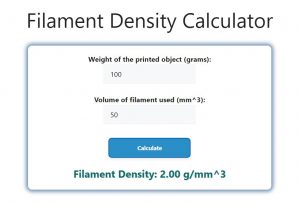About Filament Density Calculator (Formula)
The Filament Density Calculator is a vital tool for 3D printing enthusiasts and professionals looking to optimize their printing process. Understanding filament density is crucial for achieving the desired strength, flexibility, and overall quality of 3D printed objects. This calculator helps you determine the density of the filament used based on the weight of the printed object and the volume of filament consumed. In this article, we will explore the formula used in this calculation, how to use the calculator effectively, and address common questions regarding filament density.
Formula
The formula for calculating filament density is: Filament Density (FD) = Weight of the printed object (W) / Volume of filament used (VF). In this formula, Weight (W) is the mass of the final printed object in grams, and Volume of filament used (VF) is the total volume of the filament consumed in cubic centimeters (cm³).
How to Use
Using the Filament Density Calculator is straightforward:
- Determine the Weight: Weigh the final printed object using a scale to find its mass in grams.
- Calculate the Volume: Measure or calculate the volume of the filament used in the print. This is usually given in cubic centimeters (cm³).
- Input Values: Enter the weight and volume into the calculator.
- Calculate: Click the “Calculate” button to obtain the filament density.
- Interpret the Result: The output will provide the filament density in grams per cubic centimeter (g/cm³), which is essential for understanding the material properties.
Example
Let’s calculate the filament density for a printed object that weighs 100 grams and used 50 cm³ of filament.
- Weight of the printed object (W): 100 grams
- Volume of filament used (VF): 50 cm³
- Formula Application:
Filament Density (FD) = Weight of the printed object (W) / Volume of filament used (VF)
FD = 100 grams / 50 cm³
FD = 2 g/cm³
In this example, the filament density is 2 grams per cubic centimeter.

FAQs
- What is filament density?
Filament density is the mass of the filament material per unit volume, typically expressed in grams per cubic centimeter (g/cm³). - Why is filament density important in 3D printing?
Filament density affects the strength, weight, and flexibility of printed objects, influencing their performance in various applications. - How do I measure the weight of my printed object?
Use a digital scale to weigh the finished print, ensuring accurate measurement in grams. - How can I find the volume of filament used?
You can calculate the volume based on the filament’s diameter and length or obtain it from your slicing software. - What if I don’t know the filament volume?
You can estimate the volume by using the formula for the volume of a cylinder if you know the filament’s diameter and length. - Can this calculator be used for all types of filament?
Yes, the calculator can be used for various filament types, including PLA, ABS, PETG, and more. - How does temperature affect filament density?
While density remains relatively constant, temperature can affect the filament’s properties during printing, such as its flow and adhesion. - What is the typical density range for common filaments?
Common 3D printing filaments have densities ranging from about 1.2 g/cm³ (PLA) to 1.5 g/cm³ (ABS). - How can I improve the quality of my prints based on density?
Understanding filament density helps you select the right material for your application, ensuring optimal strength and flexibility. - Is a higher density always better for 3D printing?
Not necessarily; the ideal density depends on the specific application and desired properties of the printed object. - What if I accidentally overestimate the filament volume?
Overestimating the volume will result in a lower density calculation, which might not reflect the true properties of the filament. - Can this calculator assist in material selection?
Yes, by comparing densities, you can choose the appropriate filament for specific applications based on performance needs. - What are the consequences of using the wrong filament density?
Using incorrect density values can lead to poor print quality, structural weaknesses, or unexpected performance issues. - How does moisture affect filament density?
Moisture absorption can alter the properties of filament, potentially affecting density and print quality. - Can I use this calculator for filament recycling?
Yes, it can help determine the density of recycled filament, which may vary from the original material. - What factors can affect the final weight of a printed object?
Print settings, layer height, infill percentage, and support structures can all influence the final weight of the object. - Are there any tools to measure filament volume directly?
Some slicing software provides volume estimates directly, which can simplify the calculation process. - How can I ensure consistent filament density in my prints?
Use high-quality filaments from reputable manufacturers and maintain consistent printing conditions for the best results. - What are some applications where filament density is critical?
Applications in aerospace, automotive, and medical fields often require specific material properties, making density crucial. - Is there a relationship between filament density and print speed?
While not directly related, denser materials may require slower print speeds for optimal adhesion and quality.
Conclusion
The Filament Density Calculator is an invaluable resource for anyone involved in 3D printing. By accurately determining filament density, users can make informed decisions regarding material selection and printing parameters, ultimately leading to better quality prints. Understanding filament properties and their implications enhances the overall 3D printing experience, ensuring that printed objects meet the necessary performance standards. Whether you are a hobbyist or a professional, mastering filament density will significantly benefit your projects.